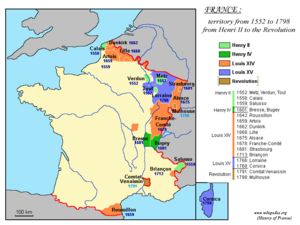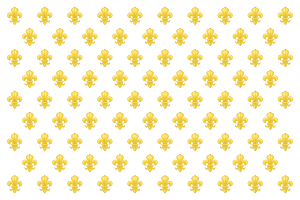France in the early modern period facts for kids
Quick facts for kids
Kingdom of France
Royaume de France (French)
|
|||||||||||||
|---|---|---|---|---|---|---|---|---|---|---|---|---|---|
|
|||||||||||||
|
Coat of arms of France & Navarre
(1589–1792) |
|||||||||||||
|
Motto:
|
|||||||||||||
|
Anthem:
|
|||||||||||||
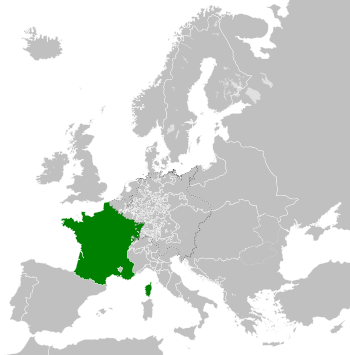
The Kingdom of France in the late 18th century
|
|||||||||||||
| Capital |
|
||||||||||||
| Common languages | |||||||||||||
| Religion | Roman Catholicism (987–1791) Constitutional (1791–1792) |
||||||||||||
| Demonym(s) | French | ||||||||||||
| Government |
|
||||||||||||
| King of France | |||||||||||||
| Legislature |
|
||||||||||||
| Historical era |
|
||||||||||||
| Currency |
|
||||||||||||
|
|||||||||||||
The Kingdom of France was a powerful country in Europe for many centuries. From the 1500s to the late 1700s, it was ruled by kings, especially from the House of Bourbon family. This time is often called the Ancien Régime (pronounced: Ahn-see-an Reh-zheem), which means "old rule."
During this period, France grew to almost the size it is today. It also started building a large empire overseas, with colonies in the Americas and other parts of the world. A very famous king from this time was Louis XIV, known as the "Sun King." He ruled for a very long time (1643–1715). He made the government much stronger and more centralized, with the king having almost all the power. This system lasted until the French Revolution began in 1789.
Contents
How France Grew: Geography and Territory
In the mid-1400s, France was smaller than it is now. Many areas near its borders, like Brittany and Provence, were independent or controlled by other countries. There were also small foreign areas inside France.
Over the next two centuries, France grew a lot. Kings worked to add these provinces and make them part of the main country. By the late 1700s, France looked much like it does on a map today.
Here are some of the areas France gained:
- Under Louis XI: Provence (1482).
- Under Henry II: Calais and the Three Bishoprics (1552).
- Under Henry IV: County of Foix (1607).
- Under Louis XIII: Béarn and Navarre (1620).
- Under Louis XIV: Alsace (1648), Artois and Northern Catalonia (1659), Franche-Comté and Flanders (1678–79).
- Under Louis XV: Lorraine (1766), Corsica (1768).
France also started exploring and setting up colonies. They had lands in the Americas (like New France and Louisiana), India, and the Indian Ocean.
The capital of France was Paris. However, some kings preferred to live in grand palaces outside the city. Louis XIV famously moved the main royal residence to the magnificent Palace of Versailles.
People and Population
The Black Death, a terrible plague in the 1300s, killed about one-third of France's population. It took until the early 1500s for the population to recover.
France was the most populated country in Europe for a long time. In 1400, about 11 million people lived there. By the 17th century, it was 20 million, and by 1789, it reached 28 million. This made France one of the most populous countries in the world, after China and India.
More and more people started living in cities, but France remained mostly a rural country. Paris was one of Europe's largest cities, with about 400,000 people in 1550. Other big cities included Lyon, Rouen, and Marseille.
Sometimes, there were periods of disease and bad harvests due to wars and changes in climate. For example, between 1693 and 1694, France lost 6% of its people. In the very cold winter of 1709, 3.5% of the population died.
Languages Spoken in France
France had many different languages and dialects. In the north, people spoke various dialects of what are called Oïl languages. In the south, people spoke Occitan languages. Other languages included Breton, Catalan, Basque, and Dutch.
Before the 1500s, Latin was the official language for legal documents. But by the 16th century, a standard form of French developed. In 1539, King Francis I of France made French the only language for legal acts.
However, even by 1790, only about half of the population actually spoke or understood standard French. The French Revolution encouraged teaching French in all schools. France did not become a country where everyone spoke the same language until the late 1800s.
How France Was Ruled: The Ancien Régime
The "Ancien Régime" was the system of government and society in France from about the 15th to the 18th century. It was a mix of old traditions, laws, and local rules. This system was quite complicated and sometimes confusing.
The kings tried to make the government more organized, but it remained a patchwork of different rules. This changed dramatically during the French Revolution, which aimed to create a much more unified system.
Important Events and Wars
Early Conflicts and Italian Wars
After the Hundred Years' War (1337–1453) with England, France became more stable. This allowed French kings to look outwards and try to expand their power. In 1494, King Charles VIII of France invaded Italy. This started a long period of wars called the Italian Wars (1494–1559).
French kings wanted to control parts of Italy, but they faced strong opposition from the Habsburg family, who ruled large parts of Europe. These wars were very costly and did not result in France gaining much territory in Italy. Instead, the Habsburgs became even more powerful.
During these wars, the French army changed. Kings started to build a regular army instead of relying on hired soldiers. By the mid-1500s, France had a standing army of thousands of cavalry and infantry.
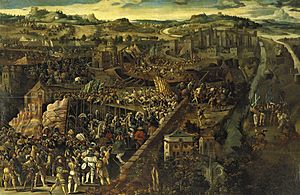
One key battle was the Battle of Pavia in 1525, where King Francis I of France was captured by his enemies. This was a big defeat for France. The wars finally ended in 1559 with the Peace of Cateau-Cambrésis. France gave up its claims in Italy.
The French Wars of Religion
Soon after the Italian Wars, France faced a huge internal crisis: the French Wars of Religion. Many people in France became Protestants, called Huguenots. The Catholic Church was the official religion, and the kings tried to stop the spread of Protestantism.
This led to many violent conflicts between Catholics and Protestants. Other European countries also got involved, supporting either side. A terrible event was the St. Bartholomew's Day massacre in 1572, where many Huguenots were killed.
The wars finally ended when Henry IV became king in 1589. He was a Protestant but converted to Catholicism to bring peace to the country. In 1598, he issued the Edict of Nantes, which gave Huguenots some rights to worship freely. This brought an end to decades of fighting.
France in the 17th and 18th Centuries
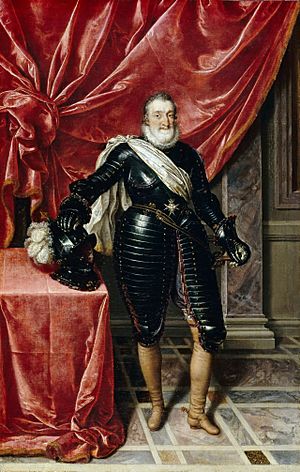
Under Henry IV, France began to become a very strong power in Europe. He was a popular king, but he was killed in 1610. His son, Louis XIII, and his chief minister, Cardinal Richelieu, continued to strengthen France. They challenged the power of Spain and the Holy Roman Empire during the Thirty Years' War (1618–1648).
After Louis XIII and Richelieu died, the young king Louis XIV came to power. His reign (1643–1715) was one of the longest in history. Louis XIV wanted France to be the most powerful country in Europe. He built the amazing Palace of Versailles to show off France's wealth and power.
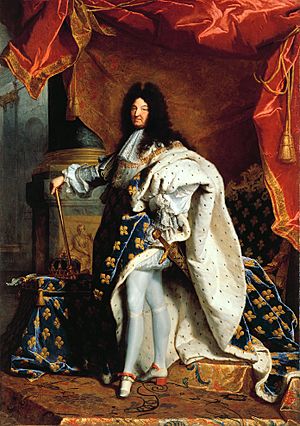
Louis XIV fought many wars to expand France's borders. These included the War of Devolution and the Franco-Dutch War. While France gained some land, these wars were very expensive. They also made other European countries form alliances against France.
Louis XIV also wanted everyone in France to be Catholic. In 1685, he cancelled the Edict of Nantes, which had protected Protestants. Many Huguenots had to leave France, which meant the country lost many skilled workers and thinkers.
Towards the end of his reign, Louis XIV fought the War of the Spanish Succession (1701–1714). This war was about who would become the next king of Spain. France was almost defeated, but managed to avoid losing territory. The war ended with an agreement that the French and Spanish thrones would never be united.
After Louis XIV, his great-grandson Louis XV became king (1715–1774). His reign saw some peace, but also costly wars like the Seven Years' War (1756–1763). In this war, France lost many of its colonies in North America to Britain.
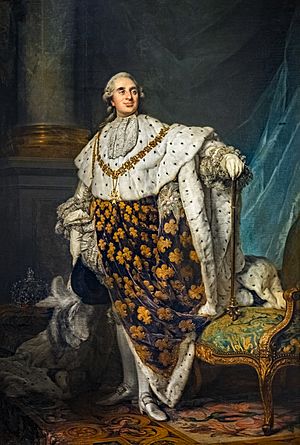
By the 1700s, many people were unhappy with the monarchy. King Louis XV was not very popular. The ideas of the the Enlightenment started to spread, with thinkers like Voltaire questioning the old ways.
When Louis XVI became king in 1774, France was deeply in debt. He tried some reforms, but they didn't work. A harsh winter in 1788 led to food shortages. By 1789, France was ready for a big change.
On September 21, 1792, the French monarchy was officially ended. France became a republic, marking the end of the Kingdom of France.
Kings of France
Here are the main kings who ruled France during this period:
Valois Dynasty (1328–1498)
Valois-Orléans (1498–1515)
Valois-Angoulême (1515–1589)
- Francis I
- Henry II (and his wife Catherine de' Medici as regent for their sons)
- Francis II
- Charles IX
- Henry III
House of Bourbon (1589–1792)
- Henry IV
- Louis XIII (with his minister Cardinal Richelieu)
- Louis XIV (with his minister Cardinal Mazarin during his early reign)
- Louis XV
- Louis XVI
Daily Life and Society
In the 1700s, France had about 22 million people. Most of them (about 96%) were peasants living in the countryside. France had the largest population in Europe.
Life in Rural Areas
In the 1600s, some wealthy peasants who were involved in trade helped agriculture grow. People often moved between villages or to towns to find work. This movement was important for people to improve their lives. Even though many people stayed in one place, there was still a lot of movement and change in society.
Women and Families
Women had limited power in society. A few queens, like Catherine de' Medici, had political influence, and some women led Catholic convents. In families, women in cities often worked alongside men, though they usually earned less.
French law prevented women from becoming queens directly. However, if a king died and his son was too young to rule, his queen could become a regent. This meant she would rule until her son was old enough, helping to keep the royal family in power.
Education for Girls
Education was becoming more important. Boys from noble and wealthy families went to upper schools and universities. Girls from these families often went to convents for their education. Working-class children, both boys and girls, often went to small local schools to learn to read.
Stepfamilies
Many children in France lived in stepfamilies because parents often died young. Children might have half-siblings or step-siblings. Sometimes, brothers and sisters were separated if their parents died, and they were raised in different homes.
Stepmothers often faced negative ideas about them, like in the Cinderella story. But many widowers remarried quickly, showing that forming new families was important. For women, being a stepmother was just one part of their lives, and their experience depended on many things, like how long they were married and their husband's financial situation.
Religion in France
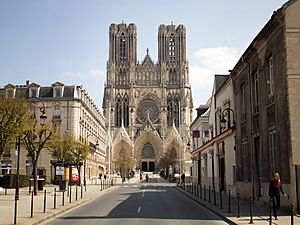
Before the French Revolution, the Catholic Church was the official religion of France. France was often called the "eldest daughter of the Church." The King of France had a close relationship with the Pope. However, the French kings also had a lot of control over the Church in France, a policy called "Gallicanism." This meant the king often chose bishops instead of the Pope.
In the 1500s, the Protestant Reformation led to many French people becoming Protestants, known as Huguenots. Their numbers grew to about 1.8 million. The French Wars of Religion caused a lot of harm to the Huguenot community. By the end of the 16th century, their numbers had dropped.
The Edict of Nantes in 1598 gave Protestants some religious freedom. But Louis XIV took away these rights in 1685. This caused many Huguenots to leave France, which was a loss for the country.
French Exploration and Colonies
France was active in the Age of Discovery. They established colonies in the Americas, including New France (modern-day Canada and parts of the USA) and Louisiana. They also had colonies in the West Indies (like Martinique and Guadeloupe), India, and some trading posts in Africa. These colonies were important for trade and expanding French influence around the world.
See also
- French Renaissance literature
- French literature of the 17th century
- French literature of the 18th century
- French Enlightenment
- Paris in the 17th century
- Paris in the 18th century






